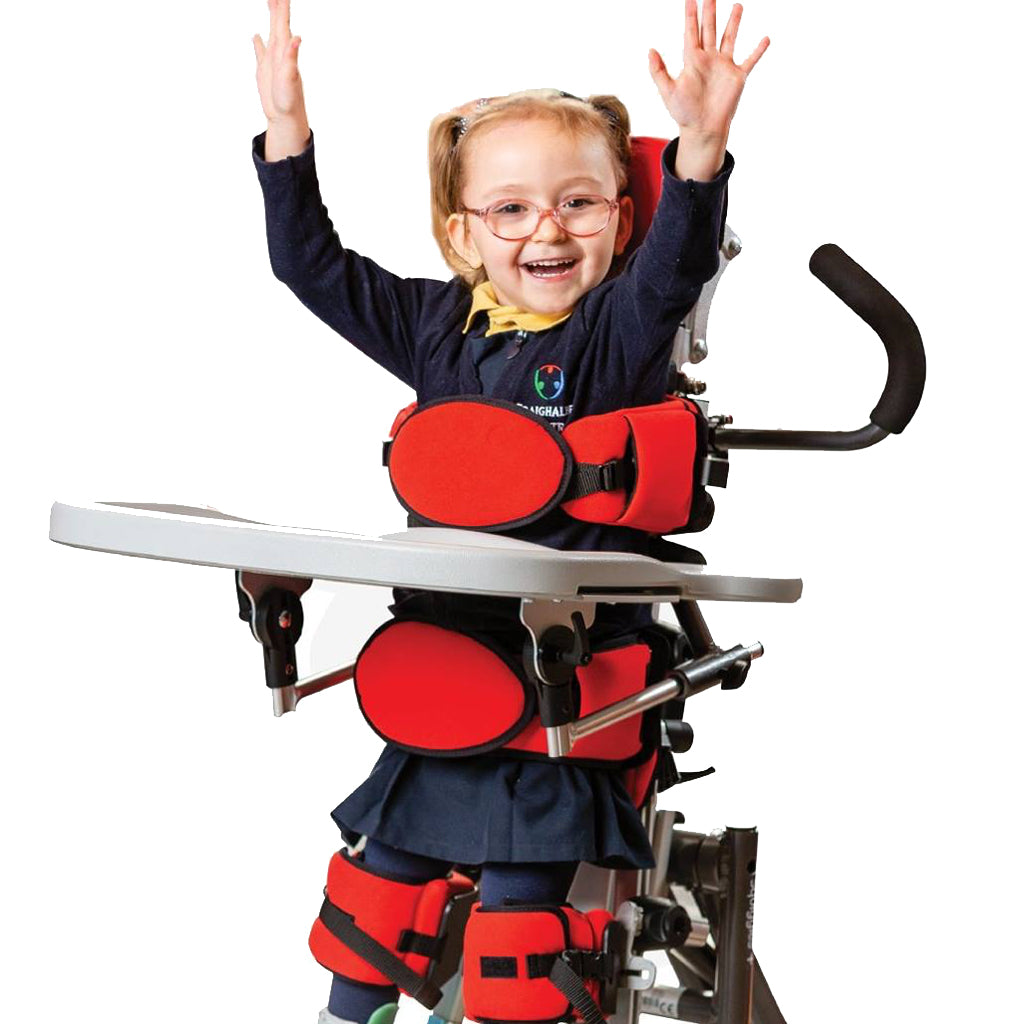Choosing the best Pediatric Special Needs Stander for your child can seem a bit overwhelming at first. Start by reading this great infographic by Leckey that describes the benefits of a pediatric standing program. While there are many suggested benefits to a standing program for your child, there are also risks that should be considered. Conditions such as severe contractures (limited joint range of motion due to tightness of muscles), skeletal deformities and bone mineral density deficiencies, lack of standing tolerance, and neurological conditions should be discussed with your child's physician and therapy team. Your child's physician should give you clearance to stand you child if they are unable to do so on their own. There is not an easy to follow flow chart that will help you choose a stander. Rather, there are a few considerations that can be grouped together. Once you have considered the points below, the decision on which stander is best for your child will seem less daunting.
Standing Support Required
The amount of standing support your child requires dramatically influences the potential choices you have. Head control and upper body function tend to drive the selection of the stander category. Many standers can be configured in more than one position, a consideration that may influence your choice as your child's standing tolerance and head control may improve over time.
Supine Standers provide the most support for children who have little or no head control. The child can be completely supported head to toe and placed on the stander in a flat or near flat position lying on their back. The stander can then be cranked upright a little bit at a time. This slowly puts weight through the child's legs. The stander is no longer cranked up when the child shows signs of not tolerating the position due to loss of head control or some other indication of discomfort. It is easiest to load a child who requires complete assistance for all transfers onto a flat supine stander. Parents of teens and young adults tend to favor supine standers that are waist high when in a flat position because it is easier on their back to lift their child on and off. Some standers can be configured in both the Supine and Prone position.
Prone Standers provide support to a child on the front of their body. Children who are able to hold their head up for some period of time are candidates for a prone stander. Prone standers do not load totally flat the way supine standers do. They lean forward and have a tray or are placed in front of a table or work surface. They work well for children with contractures of the hips and knees, allowing children to stand with flexed posture and be stretched over long periods of time with the goal of improving range of motion. Some prone standers can be fitted with wheels making it a Mobile or Dynamic Stander so the child can push around the room.
Vertical Standers
Also know as upright standers, provide support to the front of the child's body like a prone stander, but cannot lean forward and offer little support for joint contractures. Vertical standers take up less floor space than other stander types. Typically, the child transfers from a wheelchair into the vertical stander from a seated position. Feet are placed on the footplate, knees are blocked, and the child is assisted into a standing position where at a minimum, their hips are secured with a belt or solid pad. Vertical standers are beneficial for children with good head control and good trunk control.
Sit to Stand Standers
Just like it sounds, the stander can move from a seated to standing position. Children need good head control and good to moderate trunk control. One major benefit of sit to stand standers is the ability to stay in the device for longer periods of time, some while seated and some while standing. The child transfers onto the seat, feet are placed on the footplates, and knee blocks are lowered. The seat is pumped up to a support surface like a tray or chest pad, or some units have a tray that travels with the child from sitting to standing.
Dynamic / Mobile Standers
A stander that a child can move around the room themselves is a dynamic or mobile stander. They fall into two basic categories: Prone/Vertical style supports that have large wheels that kids move like a wheelchair, and sit to stand units that are fitted with a set of cranks that allow the child to reposition the stander by turning the hand wheels. These are considered for children who have strong upper bodies and the desire to move around their environment while in a supported standing position. Even for children who are using Gait Trainers, dynamic / mobile standers can be considered. They allow for prolonged standing and mobility for kids who's use of a gait trainer requires long periods of arm use. By using the dynamic stander, they can stand and. Meaning, they can stand and do something else with their hands instead of support themselves in the gait trainer.
Environment
Where the stander will be used and stored is an important consideration. Standers are large pieces of equipment and do not transport well. It is not realistic to think a stander will travel home from school on the weekends, or travel to therapy sessions. The ability of a parent or caregiver to load and unload a child (or teen) onto a stander should be considered. After 8 to 10 years of lifting a child, parents frequently have back problems. Many families consider supine standers that load at waist height and completely flat the best option. A few of these include: the Leckey Horizon, Leckey Mygo, Snug Seat Caribou, Jenx Supine, and Rifton Supine.
Tolerance
Tolerance can be broken into to components: Comfort and Fun. If it's not comfortable, your child will not want to do it. If it is fun, they will want to do it more. No one wants to force their child to do something they don't want to do. Finding a stander that is comfortable is the most important consideration. Some children can tell you if it is comfortable with words, others will tell you with their body language. Comfort can reveal itself in the length of time your child can maintain good posture in the stander. It is better to error on the of more side support when your child does not have a lot of experience using a piece of standing equipment. Also consider a piece of equipment that can transition from lots of support (supine) to less support (prone or upright). For example, selecting an upright only stander for a child with no head control or poor head control in hopes of "growing into it" is a bad idea. Fit your child's needs for today, and prepare for the future with adaptable functions.
Dosage
Many excellent Therapists are currently exploring research into the "Dosage" of standing programs (how often and for how long to use a stander). While there is not currently a proven protocol, it is suggested that to get the maximum benefit from a standing program, the stander must be used frequently (ideally every day) and for a long periods at a time (60-90 minutes). This can be a challenge for families, and why it is important to find the stander that is easiest to use, is tolerated by your child, and can be incorporated into your family's daily routine. Many children have the benefit of standing at school or in therapy, but a home program is the best way to ensure that your child is receiving an adequate dosage.








